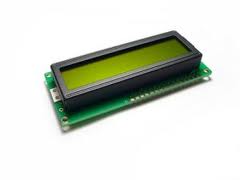Difference between revisions of "Liquid Crystal Displays (LCD)"
m (→Shipment / Storage / Risk factors) |
|||
| Line 15: | Line 15: | ||
==Shipment / Storage / Risk factors== | ==Shipment / Storage / Risk factors== | ||
Liquid Crystal Displays are utilised in the final manufacture of any electrical unit which incorporates a visual display panel, e.g. digital watch face, clock face, monitor screens on VDU, telephone systems, etc. The displays are made up of sandwiched glass plates encompassing an electrical circuit floating in a sensitive fluid. The sandwiched plates are usually flat packed on to a card sealed with shrink wrapping. Outer packing is in [[cardboard]] boxes with the cardboard holed pads packed ten to a carton, flat. <br><br> | Liquid Crystal Displays are utilised in the final manufacture of any electrical unit which incorporates a visual display panel, e.g. digital watch face, clock face, monitor screens on VDU, telephone systems, etc. The displays are made up of sandwiched glass plates encompassing an electrical circuit floating in a sensitive fluid. The sandwiched plates are usually flat packed on to a card sealed with shrink wrapping. Outer packing is in [[cardboard]] boxes with the cardboard holed pads packed ten to a carton, flat. <br><br> | ||
| − | Damage can occur by impact, and as a result the glass fractures releasing the inner fluid which can be retained with the shrink pack wrapping, or alternatively, if that suffers damage will leak. Any form of breakage or impact renders the individual display unit a total loss. The fluid contained in the liquid crystal displays is dangerous and must be handled very carefully to offset the possibility of | + | Damage can occur by impact, and as a result the glass fractures releasing the inner fluid which can be retained with the shrink pack wrapping, or alternatively, if that suffers damage will leak. Any form of breakage or impact renders the individual display unit a total loss. The fluid contained in the liquid crystal displays is dangerous and must be handled very carefully to offset the possibility of contact with eyes, skin, etc. Disposal should be under controlled conditions as the liquid is a radio-active alkaline. |
Latest revision as of 13:05, 14 January 2021
| Infobox on Liquid Crystal Displays (LCD) | |
|---|---|
| Example of Liquid Crystal Displays (LCD) |  |
| Facts | |
| Origin | - |
| Stowage factor (in m3/t) | - |
| Humidity / moisture | - |
| Ventilation | - |
| Risk factors | See text |
Liquid Crystal Displays (LCD)
Description
A liquid-crystal display (LCD) is a flat panel display, electronic visual display, or video display that uses the light modulating properties of liquid crystals. Liquid crystals do not emit light directly.
LCDs are available to display arbitrary images (as in a general-purpose computer display) or fixed images which can be displayed or hidden, such as preset words, digits, and 7-segment displays as in a digital clock. They use the same basic technology, except that arbitrary images are made up of a large number of small pixels, while other displays have larger elements.
LCDs are used in a wide range of applications including computer monitors, televisions, instrument panels, aircraft cockpit displays, and signage. They are common in consumer devices such as video players, gaming devices, clocks, watches, calculators, and telephones, and have replaced cathode ray tube (CRT) displays in most applications. They are available in a wider range of screen sizes than CRT and plasma displays, and since they do not use phosphors, they do not suffer image burn-in. LCDs are, however, susceptible to image persistence.
The LCD screen is more energy efficient and can be disposed of more safely than a CRT. Its low electrical power consumption enables it to be used in battery-powered electronic equipment. It is an electronically modulated optical device made up of any number of segments filled with liquid crystals and arrayed in front of a light source (backlight) or reflector to produce images in colour or monochrome. Liquid crystals were first discovered in 1888. By 2008, worldwide sales of televisions with LCD screens exceeded annual sales of CRT units; the CRT became obsolete for most purposes.
See also Electrical Equipment
Shipment / Storage / Risk factors
Liquid Crystal Displays are utilised in the final manufacture of any electrical unit which incorporates a visual display panel, e.g. digital watch face, clock face, monitor screens on VDU, telephone systems, etc. The displays are made up of sandwiched glass plates encompassing an electrical circuit floating in a sensitive fluid. The sandwiched plates are usually flat packed on to a card sealed with shrink wrapping. Outer packing is in cardboard boxes with the cardboard holed pads packed ten to a carton, flat.
Damage can occur by impact, and as a result the glass fractures releasing the inner fluid which can be retained with the shrink pack wrapping, or alternatively, if that suffers damage will leak. Any form of breakage or impact renders the individual display unit a total loss. The fluid contained in the liquid crystal displays is dangerous and must be handled very carefully to offset the possibility of contact with eyes, skin, etc. Disposal should be under controlled conditions as the liquid is a radio-active alkaline.











